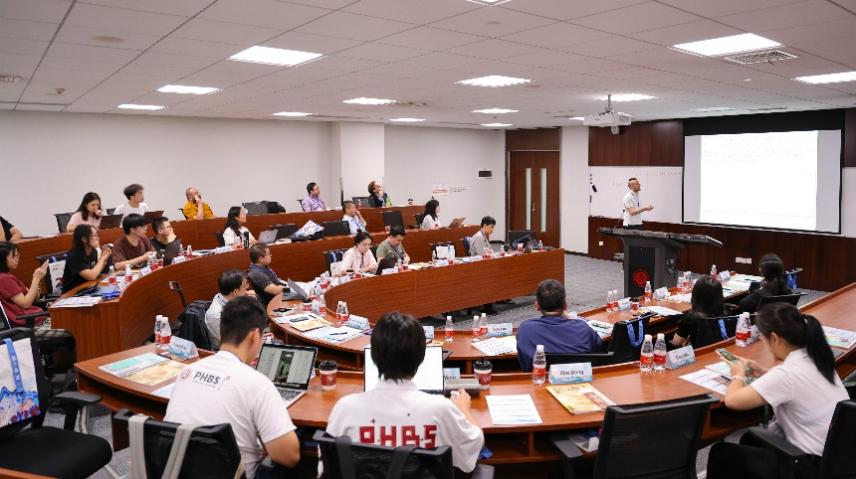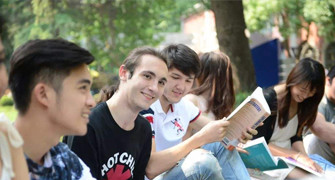On November 2nd, the Advanced Macro Workshop on Machine Learning, Mechanism Design, and Heterogeneous-Agent Models was held at the Peking University HSBC Business School. The event was jointly organized by the Sargent Institute of Quantitative Economics and Finance at Peking University, the Advanced Research Center and School of Economics and Management at Wuhan University, and the University of International Business and Economics. Over 30 scholars from mainland China and Hong Kong gathered to discuss the latest academic topics in macroeconomics, focusing on machine learning, mechanism design, and heterogeneous agent models.

In his opening speech, Professor Nie Jun, Dean of the School of Economics and Management at Wuhan University, introduced the theme of the workshop. He expressed his hope that through the paper discussions, participants would explore academic frontiers and promote collaboration. Professor Thomas J. Sargent, 2011 Nobel Laureate in Economic Sciences and Honorary Director of the Sargent Institute of Quantitative Economics and Finance at Peking University HSBC Business School, presented the current research status and challenges of the decision-making framework "Equilibrium Markov Processes." He pointed out that with the development of statistics, functions, and the improvement of computational capabilities, researchers can enhance their studies in the fields of machine learning and artificial intelligence. He expressed his expectation that the workshop would showcase the innovative applications of these groundbreaking advances.
During the workshop, Professor Lv Qi from Sichuan University introduced his paper titled "Optimal Control of Stochastic Evolution Equations: Some Recent Progresses." He pointed out that many effective tools and methods developed for deterministic distribution parameter control systems and stochastic finite-dimensional control systems are not applicable to stochastic distribution parameter systems. Therefore, there is an urgent need to develop new mathematical tools for stochastic distribution parameter systems, such as stochastic regime-switching methods and Kalman filtering. The discussion of the paper primarily focused on the controllability of stochastic hyperbolic equations and the Pontryagin-type optimality principles for controlled stochastic evolution equations.
Assistant Professor Mathieu Laurière from NYU Shanghai introduced his collaborative paper titled "A Machine Learning Method for Stackelberg Mean Field Games." In the Stackelberg mean field game, there is a two-layer problem between the leader and the agent's mean field, which traditional mean field game methods cannot solve effectively. To address this, the authors used a penalization method to transform the two-layer problem between the leader and the agent's mean field into a single-layer mean field optimal control problem. They conducted the research using feedforward and recurrent neural networks. The results of the study show that the proposed reconstruction method converges to the original problem and has been effectively applied to examples from various literature.
Professor Jentzen Arnulf from The Chinese University of Hong Kong (Shenzhen) and University of Münster presented his paper titled "Overcoming the Curse of Dimensionality: From Nonlinear Monte Carlo to the Training of Neural Networks." He proposed an efficient machine learning algorithm for approximating the solutions of high-dimensional PDEs and demonstrated that deep artificial neural networks (ANNs) can overcome the curse of dimensionality in the case of general semi-linear parabolic PDEs. The results of the study indicate that certain smooth functions cannot be approximated by shallow ANNs without being affected by the curse of dimensionality, but they can be approximated by deep ANNs without this limitation.
Professor Zhu Shenghao from the University of International Business and Economics (UIBE) presented his paper titled "Kantorovich Meets Sargent: A New Perspective of Rational Expectations." The author proposed a new approach for theoretically analyzing the evolution of distributions and beliefs in macroeconomic models, using machine learning techniques to numerically compute these abstract concepts. The author pointed out that computational methods such as Monte Carlo simulations and reinforcement learning provide new tools for macroeconomics, helping to deepen the understanding of rational expectations in uncertain environments.
Lecturer Tang Qing from China University of Geosciences presented his paper titled "Cournot Mean Field Games of Controls: Theory and Numerical Algorithms." The author used the Cournot mean field game model to study the production decision-making behavior of multiple agents in a competitive market with limited resources. During the research, the author developed a smoothing strategy iteration algorithm, combined with numerical techniques such as Monte Carlo methods, to ensure the system converges to a stable solution. This model has practical applications in fields like energy economics and environmental management, and can be used to simulate competitive behavior under resource constraints and its impact on market prices.
Professor Chen Nan from The Chinese University of Hong Kong presented his paper titled "Collusion or Compete: A Two Timescale Evolutionary Game Approach to Algorithmic Collusion Study." The author replaced the Nash Q-function with the Q-function and proposed a two-timescale evolutionary game approach, which slows down the update speed of strategy functions and belief functions, while speeding up the update of the value function. This approach successfully achieves stable equilibria without excessive constraints. Through extensive numerical simulations, the study found that collusion behavior could be sustained under conditions where both parties are sufficiently patient, neither party updates the belief function, or both parties update the belief function.
Assistant Professor Zhang Lichen from The University of Hong Kong presented her paper titled "College Access and Intergenerational Mobility." The author combined the Aiyagari lifecycle model with an overlapping generations model, endogenizing parental educational investments and introducing a human capital sorting mechanism to describe how children compete for college admission opportunities. The study found that the large-scale expansion of public universities has not effectively improved college access for low-income families. On the contrary, it has exacerbated the gap between high- and low-income families. Policies such as increasing public education spending and reducing university fees have shown limited effects on improving intergenerational mobility. The author suggests that policymakers should focus more on the differential responses of various families to these policies in order to make them more targeted.
Assistant Professor Fan Hua from Dongbei University of Finance and Economics presented his paper titled "Equilibrium Wealth and Consumption Inequality under Ambiguity Aversion." The author developed a continuous-time general equilibrium model with heterogeneous agents, incorporating ambiguity aversion into the analysis of wealth accumulation and consumption choices. The model assumes that people exhibit both risk aversion and ambiguity aversion, with bond and stock markets clearing, and the general equilibrium is solved using stochastic dynamic optimization. The study found that ambiguity aversion impacts investment behavior, thereby reducing wealth and consumption inequality. The author noted that an increase in risk, similar to an increase in ambiguity aversion, lowers inequality levels. However, an increase in risk aversion raises inequality by reducing consumption and increasing savings. Additionally, under local equilibrium, an increase in ambiguity aversion leads to welfare losses, but under general equilibrium, price changes may result in welfare gains.
This workshop not only provided a high-level communication platform for researchers in related fields but also injected new momentum into the development of machine learning and heterogeneous agent models, promoting interdisciplinary integration and development. (This event was funded by the National Natural Science Foundation's key project "Machine Learning Solution Algorithms and Application Research for Heterogeneous Dynamic Macroeconomic Models" (72433004).)

 Faculty and Staff
Faculty and Staff Academics
Academics International Exchange
International Exchange







